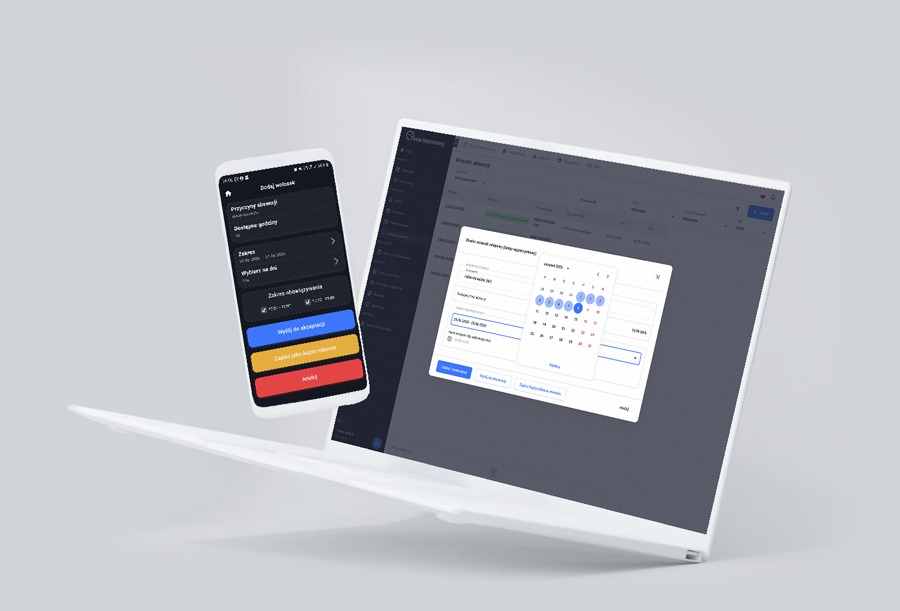Many companies mistakenly assume that an access control system vs time tracking system debate is irrelevant. In reality, understanding the differences between an access control system and a time tracking system is fundamental, as they are designed for completely different purposes, processes, and business outcomes. Knowing these differences is crucial not only for operational efficiency but also for compliance with labor law.
In this article, we explain how to distinguish an access control system from a time tracking system and why Time Harmony goes beyond traditional approaches to workforce time management.
Access control is designed for security, not time tracking
Access control systems are designed to secure physical premises. Their primary function is to regulate entry and exit to buildings or specific rooms based on employee permissions. While they record entry and exit events, this does not provide a reliable basis for payroll or HR reporting — the data is a byproduct of security functions.
Here lies a key difference between access control and time tracking systems. While an access control system only confirms door crossings, a time tracking system must accurately register the start and end of work, breaks, business trips, and other events necessary for payroll and HR compliance.
Key functions of an access control system include:
• verifying the identity of individuals entering,
• protecting restricted areas,
• recording entries and exits for security purposes,
• integration with surveillance and alarm systems.
Access control ensures infrastructure security but does not meet labor law requirements for time tracking, and therefore cannot replace a professional time tracking system.
A time tracking system is a dedicated tool for workforce management
A time tracking system is designed to provide accurate, labor law-compliant time tracking. It must account for working hours, breaks, overtime, on-call duties, absences, and all other elements required by law.
Time tracking system data forms the basis for:
• payroll calculation,
• HR reporting,
• monitoring employee duties,
• implementing schedules and analyzing efficiency.
Unlike access control, a time tracking system reflects actual work hours, not merely physical movements. Access control data often requires cleaning and interpretation, whereas a time tracking system provides complete, ready-to-use information.
Access control cannot replace a time tracking system from a legal perspective
Labor law requires time tracking to include:
• total hours worked,
• overtime,
• night shifts,
• absences,
• breaks,
• on-call duties.
Access control does not capture this information, as it is not designed for compliance purposes. Using access control data alone can lead to errors and non-compliance.
Time Harmony is an advanced time tracking system with features access control cannot offer
Time Harmony is a modern time tracking system designed to comprehensively support HR and operational processes. It includes full time tracking, overtime calculation, task analysis, and real-time reporting.
Key features of Time Harmony:
• labor law-compliant time tracking,
• automation of attendance and schedule management,
• recording breaks, departures, and returns,
• overtime, night, and holiday work calculations,
• process and task analysis,
• managerial reports,
• integration with payroll and HR systems.
Time Harmony can integrate with access control systems
Time Harmony can be integrated with existing access control systems. Combining both solutions ensures data consistency: access control manages security, while the time tracking system provides accurate workforce time tracking. This integration minimizes errors and strengthens organizational management.
Time Harmony allows field work registration through mobile GPS
Time Harmony allows employees to register work outside the office via a mobile app. Start and end of work are recorded in specific locations, and the system automatically logs GPS coordinates, confirming that tasks are performed at the designated site — e.g., at a client’s location or project site.
Benefits:
• verification of mobile teams’ work,
• reliable field work reports,
• elimination of payroll discrepancies,
• process transparency.
Access control vs time tracking system - summary
In summary, the differences between access control and time tracking systems impact both legal compliance and workforce management quality. Access control secures the premises, while a time tracking system records work. Time Harmony combines both worlds, providing security, automation, and full transparency of work hours.

Easily manage your company's working time
